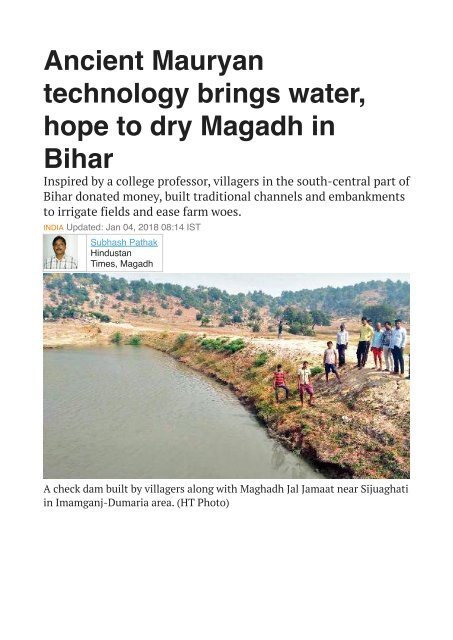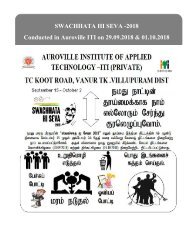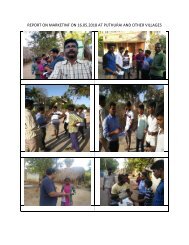You also want an ePaper? Increase the reach of your titles
YUMPU automatically turns print PDFs into web optimized ePapers that Google loves.
<strong>Ancient</strong> Mauryan<br />
<strong>technology</strong> br<strong>in</strong>gs water,<br />
<strong>hope</strong> <strong>to</strong> <strong>dry</strong> <strong>Magadh</strong> <strong>in</strong><br />
<strong>Bihar</strong><br />
Inspired by a college professor, villagers <strong>in</strong> the south-central part of<br />
<strong>Bihar</strong> donated money, built traditional channels and embankments<br />
<strong>to</strong> irrigate fields and ease farm woes.<br />
INDIA Updated: Jan 04, <strong>2018</strong> 08:14 IST<br />
!<br />
Subhash Pathak<br />
H<strong>in</strong>dustan<br />
Times, <strong>Magadh</strong><br />
A check dam built by villagers along with Maghadh Jal Jamaat near Sijuaghati<br />
<strong>in</strong> Imamganj-Dumaria area. (HT Pho<strong>to</strong>)
<strong>Ancient</strong> Mauryan eng<strong>in</strong>eer<strong>in</strong>g has brought water back<br />
<strong>to</strong> the undulat<strong>in</strong>g and rocky terra<strong>in</strong> of <strong>Magadh</strong>, the<br />
gra<strong>in</strong> bowl of <strong>Bihar</strong> that had turned almost entirely<br />
arid because of abortive modern irrigation policies.<br />
The <strong>Magadh</strong> region, compris<strong>in</strong>g 10 districts <strong>in</strong> southcentral<br />
<strong>Bihar</strong>, was reel<strong>in</strong>g from its worst water crisis<br />
over a decade ago, forc<strong>in</strong>g farmers <strong>to</strong> board tra<strong>in</strong>s <strong>to</strong><br />
distant cities such as New Delhi and Chandigarh and<br />
work there as migrant labourers.<br />
Ra<strong>in</strong>fall was scant, people had long abandoned<br />
traditional reservoirs that caught and s<strong>to</strong>red<br />
ra<strong>in</strong>water run-off, the water table <strong>in</strong> aquifers had<br />
depleted from overuse, and modern irrigation canals<br />
covered only a small area.<br />
Gaya itself was a modern nightmare as most of its<br />
ponds overflowed with garbage. The water table had<br />
dipped below 200 feet, and taps and tube wells had<br />
gone <strong>dry</strong>. The water crisis was so acute that people<br />
sold their houses <strong>in</strong> posh localities at throwaway<br />
prices. The government promised <strong>to</strong> build a 100km<br />
canal from the Ganga, but the project failed.<br />
The crisis looked irreversible but Rab<strong>in</strong>dra Pathak,<br />
who taught Pali and Sanskrit at a college <strong>in</strong> Arwal,<br />
was certa<strong>in</strong> that the answer lay <strong>in</strong> the long-forgotten<br />
and crumbl<strong>in</strong>g aqueducts and water reservoirs that<br />
irrigated the fields and fed ancient India’s most<br />
glorious empire.
He pored through old books and scriptures, and found<br />
that reviv<strong>in</strong>g the dilapidated network of pynes and<br />
ahars was the lone solution.<br />
Pynes are channels carry<strong>in</strong>g water from rivers. Ahars<br />
are low-ly<strong>in</strong>g fields with embankments that act as<br />
water reservoirs. This comb<strong>in</strong>ed irrigation and water<br />
conservation system dates back <strong>to</strong> the Mauryan era<br />
that flourished <strong>in</strong> <strong>Magadh</strong> 2,000 years ago.<br />
Eas<strong>in</strong>g farm distress<br />
The res<strong>to</strong>red pyne-ahar system brought water <strong>to</strong> the remote<br />
countryside and helps farmers <strong>in</strong> Gaya
Major pynes <strong>in</strong> district<br />
Barki Pyne, Jamune Dasa<strong>in</strong> Pyne, Moratal Pyne, N<strong>in</strong>sar Pyne,<br />
N<strong>in</strong>sar-Shakurabad Pyne, Bansi Nala-Karamdih-Pale Pyne and<br />
Bargawan Pyne<br />
Grounwater depletion over the years <strong>in</strong> Gaya
Pathak founded the <strong>Magadh</strong> Jal Jamaat (MJJ) <strong>in</strong> 2006,<br />
a network of <strong>in</strong>dividuals work<strong>in</strong>g <strong>to</strong> revive the
neglected pynes and ahars. “There was no other way<br />
<strong>to</strong> solve the recurr<strong>in</strong>g water crisis threaten<strong>in</strong>g <strong>to</strong> turn<br />
the region arid. Reckless use of tube wells for<br />
irrigation without adequate recharge complicated the<br />
scenario,” he said.<br />
Conv<strong>in</strong>c<strong>in</strong>g people <strong>to</strong> participate was not easy <strong>in</strong> a<br />
fragmented society, where nobody was will<strong>in</strong>g <strong>to</strong> part<br />
with an <strong>in</strong>ch of land.<br />
“Villagers shrugged off the idea of collective<br />
participation <strong>in</strong>itially, as they couldn’t fathom its<br />
impact,” said Kanchan Mistri at Khaneta-Pali village.<br />
“When the government with all its resources failed,<br />
how could a group (like ours) do it? That was the<br />
common refra<strong>in</strong>.”<br />
Besides, the local mafia <strong>in</strong>terested <strong>in</strong> contracts for<br />
government projects posed a big threat <strong>to</strong> the<br />
voluntary <strong>in</strong>itiative. A years before MJJ’s formation, <strong>in</strong><br />
2004, social activists Sarita and Mahesh, work<strong>in</strong>g on<br />
an irrigation system <strong>in</strong> Gaya, were murdered by the<br />
mafia.<br />
But Pathak was determ<strong>in</strong>ed <strong>to</strong> do the unth<strong>in</strong>kable —<br />
br<strong>in</strong>g water <strong>to</strong> the area. He got ample help from his<br />
professor-wife, Pramila, and trader Prabhat Pandey.<br />
They persuaded villagers <strong>to</strong> form committees and<br />
donate anywhere between Rs 100 and Rs 1,000,<br />
depend<strong>in</strong>g on the size of agricultural plots they<br />
owned, and revived the 125-km Jamune Dasa<strong>in</strong> pyne<br />
and 159-km Barki pyne. These two complex channels,
ebuilt with help from social worker Chandra<br />
Bhushan, brought water from Falgu, a tributary of the<br />
Ganga.<br />
The impact was <strong>in</strong>stantaneous and miraculous. About<br />
150 villages along the Jamune-Dasa<strong>in</strong> pyne and<br />
around 250 villages along the Barki canal have been<br />
able <strong>to</strong> irrigate their fields for the kharif and rabi<br />
(monsoon and w<strong>in</strong>ter) crops, and grow vegetables,<br />
pulses and oilseeds as well.<br />
The farm distress eased significantly. Life changed for<br />
marg<strong>in</strong>al farmer Jairam Bhagat, who wanted <strong>to</strong> kill<br />
himself when his paddy crop failed <strong>in</strong> 2007, after he<br />
met volunteers of the <strong>Magadh</strong> Jal Jamaat. He jo<strong>in</strong>ed<br />
the group, discarded plans <strong>to</strong> return <strong>to</strong> Chandigarh<br />
where he worked as a plumber, and contributed his<br />
mite for the irrigation system.<br />
Bhagat, 45, from Shabaazpur village <strong>in</strong> Gaya was<br />
among thousands of people from about 700 villages<br />
who used <strong>to</strong> migrate for work — not by choice, but by<br />
compulsion. He now stays home and reaps a good<br />
harvest from his amply irrigated farm.<br />
People began <strong>to</strong> say the water system’s revival was<br />
the second-best th<strong>in</strong>g <strong>to</strong> have happened <strong>to</strong> Gaya after<br />
the Buddha’s enlightenment. In Gaya, residents,<br />
officials, military and police personnel jo<strong>in</strong>ed the
mission <strong>to</strong> build check dams and clear ponds of<br />
encroachment and debris.<br />
“Recurr<strong>in</strong>g protests over water crises are now a th<strong>in</strong>g<br />
of past <strong>in</strong> the district. Hand pumps and wells that<br />
were abandoned are now work<strong>in</strong>g,” said Rajesh<br />
Kshitij, a lawyer <strong>in</strong> Gaya.<br />
The social organisation’s <strong>in</strong>itiative drew accolades<br />
from environmentalists Anupam Mishra and<br />
Magsaysay w<strong>in</strong>ner Rajendra S<strong>in</strong>gh.<br />
In 2011, chief m<strong>in</strong>ister Nitish Kumar asked the<br />
irrigation, public health and eng<strong>in</strong>eer<strong>in</strong>g, and the<br />
revenue and land reforms departments <strong>to</strong> replicate<br />
the <strong>Magadh</strong> Jal Jamaat model.<br />
The <strong>Magadh</strong> region has four medium and major<br />
irrigation projects, <strong>in</strong>clud<strong>in</strong>g the Sone canal. But<br />
these irrigate only 30,000 hectares <strong>in</strong> parts of Gaya,<br />
Arwal, Jehanabad, Aurangabad, Nalanda and Nawada<br />
districts.<br />
The North Koel reservoir scheme <strong>in</strong> Jharkhand’s<br />
Palamau and Punpun barrage <strong>in</strong> Gaya were launched<br />
<strong>in</strong> 1972 and 2006 respectively. But they never <strong>to</strong>ok off.<br />
The Gaya circle irrigation department’s executive<br />
eng<strong>in</strong>eer, Ashok Kumar Choudhary, said the exist<strong>in</strong>g<br />
canal system works only for the kharif season, or<br />
monsoon crop.<br />
But the res<strong>to</strong>red pyne-ahar system helps farmers grow<br />
paddy <strong>in</strong> 150,000 hectares, wheat <strong>in</strong> 100,000 hectares
and pulses and oilseeds <strong>in</strong> about 30,000 hectares <strong>in</strong><br />
Gaya alone.<br />
The Mauryan network br<strong>in</strong>gs water <strong>to</strong> the remote<br />
countryside, which seldom got any help from<br />
government agencies because of Maoist <strong>in</strong>surgents<br />
active <strong>in</strong> those areas.<br />
The <strong>Magadh</strong> Jal Jamaat responded positively when at<br />
least seven villages <strong>in</strong> the Maoist heartland of<br />
Imamganj- Dumaria requested for a check dam <strong>to</strong> be<br />
built <strong>to</strong> conserve ra<strong>in</strong>water. The area is about 22km<br />
off GT Road, but barely accessible.<br />
“Our volunteers worked two months, built a check<br />
dam and rejuvenated a pyne, which is now irrigat<strong>in</strong>g<br />
farms of over a dozen of villages and recharg<strong>in</strong>g ahars<br />
and ponds,” said 60-year-old Kameshwar Yadav of<br />
Pachman, plough<strong>in</strong>g his field after a decade.<br />
The move encouraged a farm turnaround and migrant<br />
youth work<strong>in</strong>g <strong>in</strong> Delhi returned home <strong>to</strong> sow<br />
oilseeds.<br />
“We built the dam with Rs 44,000 <strong>in</strong> 2014 when the<br />
state would have spent Rs 50 lakh and taken a year.<br />
This year, we <strong>hope</strong> <strong>to</strong> grow fish and reap a bumper<br />
rabi crop,” said Niranjan Yadav, a 30-year-old who<br />
worked at a retail shop <strong>in</strong> Delhi.
















